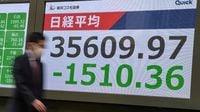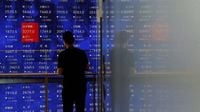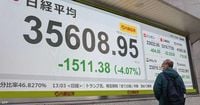The Japanese Nikkei index closed near an 8-month low on Monday, March 31, 2025, dropping 4.05 percent to 35,617.56 points. This marked the index's lowest closing level since early August, following a significant decline in Wall Street stocks during the previous session. Investors are increasingly concerned about the implications of potential U.S. trade tariffs, which have led to a wave of selling in Asian markets.
The Nikkei's decline represents its largest daily drop since the infamous "Black Monday" crash in 1987 and the most significant decrease since September 30, 2025. Meanwhile, the broader Topix index fell by 3.5 percent to 2,658.73 points, reflecting the overall bearish sentiment in the market.
Hiroyuki Ueno, a senior expert at Sumitomo Mitsui Trust Asset Management, commented on the situation, stating, "Investor sentiment has retreated due to the increased vigilance regarding American trade policies." He noted that investors are currently in a risk-averse mode, leading them to divest from their holdings. However, Ueno suggested that once clarity on the new tariffs emerges, buying activity could resume.
U.S. President Donald Trump is expected to unveil a substantial tariff plan on Wednesday, April 2, 2025, dubbed "Liberation Day." This plan is anticipated to include tariffs on aluminum, steel, and automobiles, in addition to increasing tariffs on all goods imported from China. Trump indicated that the new tariffs would affect all countries, not just a select group of 10 to 15 nations that have significant trade imbalances with the U.S.
The repercussions of these anticipated tariffs have already been felt on Wall Street, where major technology companies, such as Amazon and Microsoft, experienced sharp declines. On Friday, March 28, 2025, the Dow Jones Industrial Average fell by 715 points, or 1.7 percent, closing at 41,584 points. The S&P 500 index dropped by 112 points, or 2 percent, to 5,581 points, marking one of its worst days in two years. The Nasdaq Composite index also suffered, falling by 481 points, or 2.7 percent, to 17,323 points.
In Japan, the fallout from these developments was evident across various sectors. Shares of Fast Retailing, the parent company of Uniqlo, fell by 3.67 percent, while Tokyo Electron and Advantest, both key players in the semiconductor industry, saw declines of 6.57 percent and 7.65 percent, respectively. Additionally, shares of Mitsubishi UFJ Financial Group and Sumitomo Mitsui Financial Group dropped by 4.62 percent and 3.58 percent, respectively. The automotive sector was not spared, with Toyota Motor shares declining by 3.13 percent and Honda Motor shares dropping by 3.97 percent.
Amidst this turmoil, there was a small silver lining. Nitori Holdings, a company specializing in home decor and furnishings, saw its shares rise by 2.28 percent, standing out as one of the few gainers in a largely bearish market.
In broader regional markets, the Hang Seng index in Hong Kong fell by 1 percent to 23,200 points, while the Shanghai Composite index dropped by 0.5 percent to 3,334 points. In South Korea, the Kospi index declined by 2.6 percent to 2,492 points, and the Australian S&P/ASX 200 index saw a decrease of 1.6 percent to 7,857 points. The Taiwanese Taiex index also fell, down by 3.4 percent.
As investors grapple with the uncertainty of U.S. trade policies, commodities have also been affected. On Monday, March 31, 2025, the price of West Texas Intermediate crude oil rose by 40 cents to $68.90 per barrel, while Brent crude increased by 36 cents to $72.40 per barrel. In currency markets, the U.S. dollar experienced fluctuations against the Japanese yen, reaching 148.86 yen from 149.8 yen, while the euro rose to $1.0838 from $1.0803.
In the precious metals market, gold prices surged by more than 1 percent, reaching a historic high above $3,100 per ounce. This increase is attributed to heightened demand from central banks and a growing unease in the geopolitical landscape. Since the beginning of the year, gold prices have risen by nearly 18 percent, with expectations that they could reach as high as $3,300 per ounce by the end of the year, according to Goldman Sachs.
As the week unfolds, all eyes will be on the U.S. government’s announcement regarding tariffs and how it will shape the global economic landscape. Investors are hoping for clarity that could stabilize the markets and restore confidence in the face of rising inflation and economic uncertainty.






